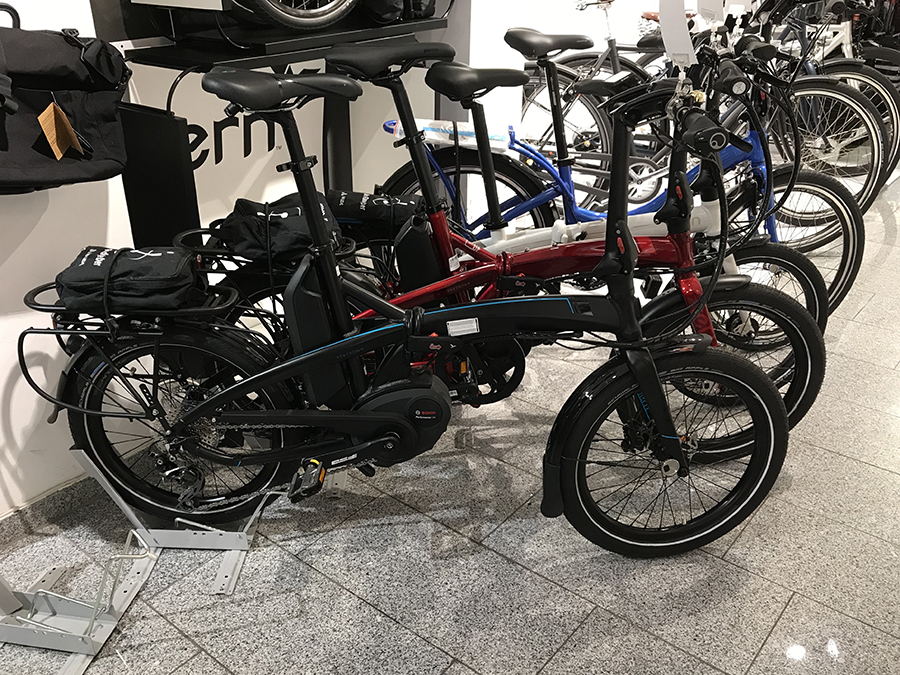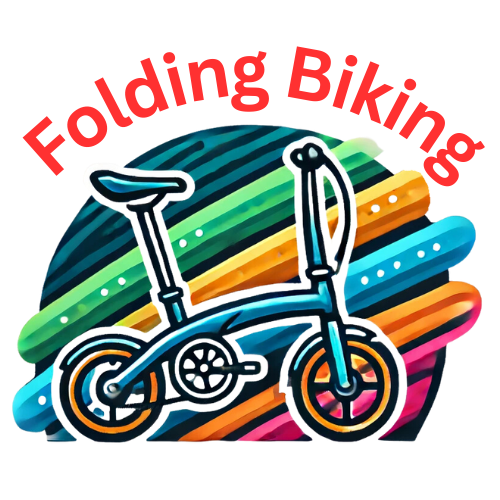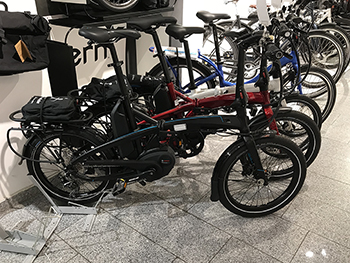
Q: Why would I use a folding electric bike over a regular folding bike?
A: If you are using a folding bike to commute any distance that takes 20 minutes or more you are bound to sweat enough that you’ll need a shower when you get to work and back home. With an e-bike you can get to work with little sweat and not not to spend time taking a shower before working at the office. Plus, some peoples offices do not have showers so people will not have to take a sink bath before going to their desk.
A: If you are older and riding a regular folding bicycle is becoming difficult but you love to ride a bike, then riding an e-bike becomes a great alternative.
A: If you have not ridden a bike in a long time and are considering buying a folding bike then getting an e-bike might be worth buying. The e-bike will allow you to slowly get your legs back in shape where getting a folding bicycle means you are doing all the work for the entire ride. Plus, with an e-bike you can go longer distances than you could with a regular folding bike.
A: If you live in an area with lots of hills or a town with steep hills an e-bike can be a life saver to assist you in getting up those hills without having to walk. I drove my folding bike from the car service center to work and had to walk up the hill because I didn’t have the pedal power I needed. Plus, it was a longer distance than I was used to and boy was I sweating when I got to work. If I had had an e-bike that would have been perfect.
A: If you have a riding partner and your normal riding speed is different, then you can make up the gap in your speeds with an e-bike.
Q: Should I buy a bike with a mid-drive motor or hub-motor?
A: A mid-drive motor has better hill climbing, lower and centered weight distribution, uses the gears, and gives overall better performance. However, a mid-drive motor is more expensive and puts more stress on the drive-train.
A: A hub drive is cheaper, can be put on the front hub, put less stress on the drive-train, and can be replaced more easily with available motors. However, a hub drive is heavier and has a uneven weight distribution, does not climb steep terrain as well, and has a more limited top speed.
A: The real answer is that it will depend on where you live, how you drive, how much you are willing to spend, and what you are looking for in an e-bike. Be sure to test ride several e-bikes so you know how they feel and respond to your driving.
Q: Why don’t more e-bikes use regenerative braking?
A: The simple answer is that it is not efficient or practical. Why? It requires a heavier motor and once the battery has no charge you are not only pushing against the bike but you are also pushing against the motor unlike a normal motor for an e-bike. You are only getting about five percent more per charge on a ride.
So, if you get 20 miles on a charge you increase that to 21 miles. The regeneration process will heat the battery and that is not good for the lifespan of lithium batteries, which are what are normally used on e-bikes. Finally, you are adding more weight for the frame to hold that already has a limit that is less than a normal bike.
Q: What is the range I can get from a single charge?
A: The “simple” answer is anywhere from 20 to 50 miles. But, there is no simple answer to this question. There are many variables that contribute to the range one can get on an e-bike. The most important points are the battery voltage, battery amp-hour capacity, total weight of the bike when ridden, ground contour (hills or flat), wind, how much pedal assist is used and several other factors.
Q: How long does it take to charge an electric bike battery?
A: Here is the answer you will get if you google it, “A lithium ion e-bike battery that is fully depleted will take 3.5 to 6 hours to recharge”. And, here is a better answer. A normal 5 amp charger takes on hour to charge 5 amps.
So, if you have a 15 amp battery it would take 3 hours. However, most batteries slow the charge when they get to about 90 percent of the charge so it actually takes longer than that. As a side note, it is not safe to try and charge the battery at a faster rate with a larger amp charger. The charging process heats up the battery, so a faster charge creates more heat and reduces the life span of the battery, as well.
Q: How many charges can I get out of a battery?
A: Lithium batteries may hold up to 1000 charge cycles, or more with the latest lithium iron phosphate batteries. Be sure the battery comes with a two year warranty. This will help protect you from a low quality build in the battery that you purchased.
Q: How much electricity does it take to charge a battery?
A: Depending on the capacity of the battery, it will usually take 400-500 watt hours (0.4 – 0.5 kilowatt hours) to charge the battery. Assuming a rate of $0.15/kWh, it will cost you 6 to 7.5 cents for a charge that will last you 20-50 miles. You will need to look at what your electricity costs based on the time you are doing the charging. Some places have variable rates based on the time of day.
Q: How much will I reduce my carbon footprint if I use an e-bike instead of a car?
A: One of the best answers I saw came from Brian Rose in his post “1000 miles of e-biking and carbon emissions.” To sum it up he had to figure out 1) how much fossil fuel was used to generate the electricity he was using, 2) how much a full charge costs in terms of kWh, and 3) how much electricity his riding consumed over a specified distance. The end result was that using an e-bike left a carbon footprint that was 100 times smaller than driving his car.
Q: How fast can an electric bike go?
A: Due to regulatory limits in the US and Europe an e-bike will assist up to 20 mph (32 kph) and 15 mph (25 kph), respectively. Off-road e-bikes can go up to 25 mph (40 kph) because they are not restricted by those same laws. There are faster e-bikes; however by law they fall under motorized bikes and not bicycles so I am not going to look into those.
Q: How important is wattage?
A: Once again regulatory requirements limit the wattage an e-bike can have in the US and Europe. In the US the limit is 500 watts and in Europe the limit is 250 watts. Having said that, the wattage is obtained by multiplying volts times amps so two different folding e-bikes with a 500 watt motor could have completely different results in terms of power produced and length of time that the battery can provide electricity. The other factor to consider is the design of the electric motor and the gearing on the folding e-bike.
Therefore the more important question is do you need a bike with longer range or more power? As an example, a bike with 10Ah x 36v = 360Wh will give you longer range and a bike with 5Ah x 72v = 360Wh will give you more power and less range.
Q: Can I ride an e-bike as a regular bike, that is without the electric power?
A: Yes! Of course a folding e-bike will be heavier than a regular folding bike so you will have to push more weight. That just means a more exercise and there is nothing wrong with that. You may be able to reduce the weight of the e-bike by leaving the battery home, depending on how it is mounted and whether or not you will need the power for part of your ride.
And, on an e-bike with a direct drive motor you will also be pushing the resistance from the motor itself along with the extra weight of the e-bike system.
Q: Do I have to pedal an electric bike?
A: It depends on the country where you live. In Europe, pedal assist is required meaning the e-bike will only give you power while you are pedaling. In the US there are some e-bikes that are operated by turning a throttle, just like you would for a moped or motorcycle. And, depending on the terrain that you encounter you may still have to pedal on hills to help the e-bike get over them.
Q: Do you need a license to drive an electric bike?
A: No, as long as the e-bike falls within the requirements to be considered a bike and not a motorized bike. Be sure to check the laws in the state and/or country where you live. Below is a general guideline.
In the US the bike can only assist up to 20 mph (32 kph) and in Europe it can only assist up to 15 mph (25 kph). There is also a limit to the maximum amount of watts; 500 in the US and 250 in Europe.
Q: Can I leave my electric folding bike in the rain?
A: Yes. However, I would read the manual carefully to understand the limitations that come with your e-bike. Having said that, why would you? To me one of the reasons for having any kind of folding bike is that it allows me to store the bike conveniently indoors and out of the weather.
Q: Can I ride my electric bike in the rain?
A: Yes, most batteries are waterproof and the other components are water resistant. If you live in an area where you expect to ride your bike in the rain frequently be sure to choose an e-bike that is better made for that purpose. At the very least you could see how you can help prevent water from getting to the areas that are not waterproof.
Q: Are electric bikes heavy?
A: Electric folding bikes are heavier than their counterpart folding bikes because you have to add the weight of the battery, electric motor, and controllers. As an example, the Brompton Electric weighs 37 pounds (16.8 kg) more than the original. The advantage is that the electric motor will more than carry the extra weight, especially when having to go up inclines.
The disadvantage is if you do not have access to the ground floor or you do not have access to an elevator if living on an upper floor.
Q: What is the difference between Class 1, Class 2 and Class 3 electric bikes in the US?
A: This system of classifying electric bikes has been adopted by several states as a means of regulating electric bikes. The classifications are as follows:
Class 1 – is a bicycle equipped with a motor that provides assistance only when the rider is pedaling (no throttle), and that ceases to provide assistance when the bicycle reaches the speed of 20 miles per hour.
Class 2 – also known as a “low-speed throttle-assisted electric bicycle” is a bicycle equipped with a motor that may be used exclusively to propel the bicycle (in other words without pedaling), and that is not capable of providing assistance when the bicycle reaches the speed of 20 miles per hour.
Class 3 – also known as a “speed pedal-assisted electric bicycle,” is a bicycle equipped with a motor that provides assistance only when the rider is pedaling, and that ceases to provide assistance when the bicycle reaches the speed of 28 miles per hour, and is equipped with a speedometer.
For all classes, the maximum power output is 750 watts.
Here is a list of states that support this class system:
Perhaps the most important aspect of this classification system is how some states are treating Class 3 e-bikes. While these bikes are permitted in bike lanes on streets, they might be restricted from shared use paths, such as those in parks and “rails-to-trails” paths that are designed to be shared by cyclists and pedestrians. In such cases, access to Class 3 bikes may be allowed if all municipalities that share the path decide to permit them.
Q: What are electric bike prices?
A: You can shop electric bikes on Amazon for current prices.


Leave a Reply